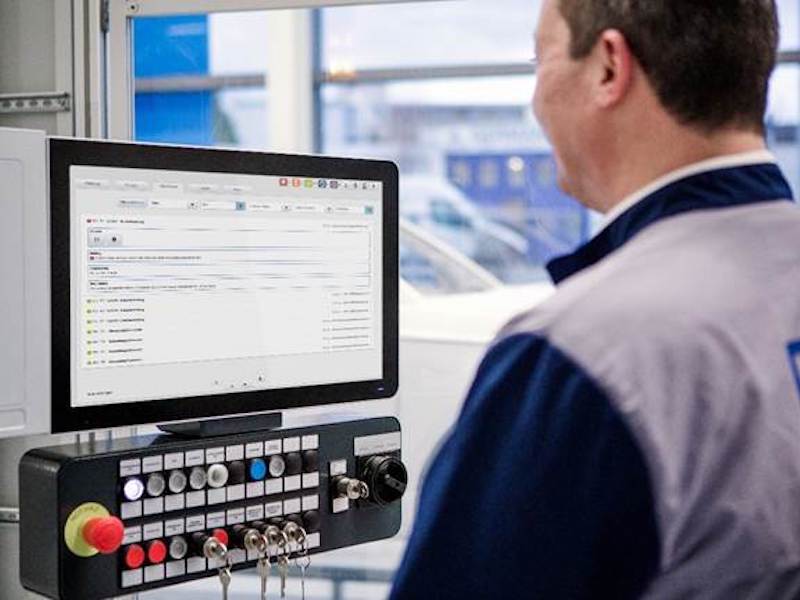Identifying defect sources, determining the optimal maintenance schedule, improving manufacturing processes: until now, artificial intelligence only made this possible in a paint shop equipped with state-of-the-art robots.
Now, however, Dürr is significantly expanding the scope of its AI applications with the enablement of analysis software from the DXQ product family for sealing. In addition, a unique interface solution makes it possible to incorporate robots from existing paint shops for the first time.
Factories in the automotive industry have enormous amounts of latent data about manufacturing processes, raw materials and products. The key to leveraging this asset is connectivity – in other words having the right interface at the control level to get at the information provided by robots, ovens, cathodic electrocoating systems or conveyor technology in the first place.
Increasing application quality and plant availability using modern IT technologies involves recording relevant machine data, such as axis positions and temperatures or events like alarms and the start and end times of programs, in real-time and uploading them to a database. “Without this basic prerequisite, software from our DXQ family cannot determine the current state of plant components. The goal is then to combine this with historical data and machine learning to detect previously unknown defect sources or to precisely plan maintenance intervals,” explains Jens Häcker, Vice President Control Systems at Dürr.
Connectivity for existing plants
Although the demand for digital applications is high, operators in existing plants are constrained because most of their systems do not have connectivity and the right interface for data acquisition is found only in the later generation of Dürr robots. Previously, earlier models, robots from other manufacturers and technology outside of paint application could not be connected. But Dürr found a way to bring connectivity to almost all common robots and disciplines.
Detailed information from all process steps
The solution is an adapter made up of hardware and software components that can connect to all current fieldbus technologies and that provides data in the necessary high temporal resolution of a few milliseconds. The adapter is offered by Dürr in cooperation with Techno-Step, a specialist in systems for process data analytics and diagnostics that has been part of the Dürr Group since 2020. “Operators are thus able to read the available sensor and actuator data from their existing plants and to integrate the entire spectrum of disciplines, from pretreatment to application to conveyor technology, into one piece of analytical software. With DXQequipment.analytics they get detailed insight into the various process steps and all the systems involved in them along the entire value chain,” says Jens Häcker.
Expertise in mechanical engineering and IT
The DXQ equipment.analytics software package includes the Advanced Analytics module. It is the first market-ready solution to date to use artificial intelligence (AI) to increase overall equipment effectiveness in the paint shop. Dürr has expanded this module for sealing by adapting the AI models that analyze the robot and process data for this discipline’s specific requirements. To meet this challenge, Dürr utilized their comprehensive expertise in production technology and manufacturing processes in the automotive industry and a high level of digital knowledge. This combined expertise will make it possible to use AI in the future to precisely detect defect sources at an early stage when applying high-viscosity materials and to determine optimal maintenance schedules. One example is the detection of nozzle clogs. The sealing material partially clogs the application nozzle, changing the material jet and leading to quality defects that require rework to fix. Unlike conventional control technology, the DXQ software detects this defect and enables earlier intervention.
About Dürr
The Dürr Group has been established in the United States since 1970 and currently employs approximately 1,400 people. From the Campus with a state-of-art validation, testing, and training center in Southfield, MI, Dürr USA represents four of the five divisions. Paint and Final Assembly Systems offers equipment for painting and assembly processes, while Application Technology provides paint, sealants and adhesives application systems. Dürr's Clean Technology Systems division is leading in air pollution control, noise abatement systems, and battery electrode coating lines. Dürr has three locations in the US: Dürr Systems, Inc. in Southfield, MI, and De Pere, WI; Durr Universal, Inc. in Stoughton, WI. The subsidiary Schenck USA Corp., with headquarters in Deer Park, NY, and additional locations in Hudson, MA, and Southfield, MI, offers balancing machines, vibration and condition monitoring systems, spin testing and services for the aerospace, automotive and general industry. The customers of Dürr USA include automotive and commercial vehicle manufacturers, as well as their suppliers, and a diverse group of other industries like the chemical or wood industry. HOMAG Machinery North America operates the production facilities for HOMAG Group in Grand Rapids, MI, which is also the base for the sales and service company Stiles Machinery Inc. The HOMAG Group produces machinery and equipment for the woodworking industry. Visit http://www.durr.com/































